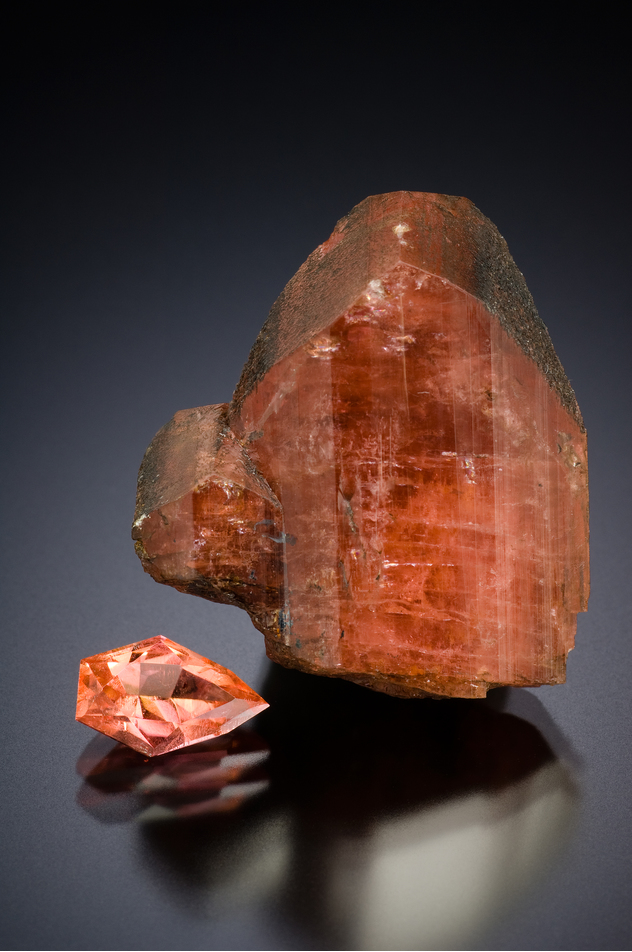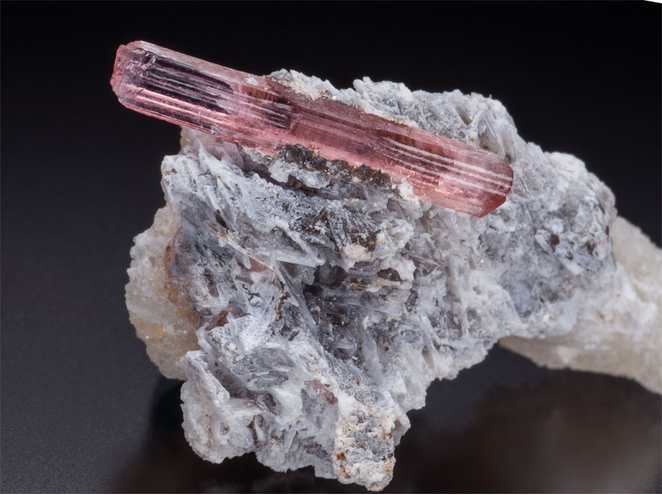Väyrynenite (original) (raw)
A valid IMA mineral species - grandfathered
About VäyryneniteHide
This section is currently hidden. Click the show button to view.
May contain minor F substituting for OH.
Colour:
Light pink to rose-red, salmon pink, pale gray, brown
Crystal System:
Monoclinic
Name:
Named after Heikki Allan Väyrynen (18 May 1888, Pielisjärvi, Finland - 29 August 1956), professor of mineralogy, Technical University, Helsinki (Finland).
The manganese-beryllium-phosphate väyrynenite was first recognized in 1939 as a possible new mineral by Oleg von Knorring (1915-1994). However, it was first described as a new mineral by Volborth (1954), from Viitaniemi, Eräjärvi, Finland. Additional mineralogical data and a new chemical analysis were given by Mrose and von Knorring (1959).
Unique IdentifiersHide
This section is currently hidden. Click the show button to view.
Long-form identifier:
mindat:1:1:4220:4
d06d41d2-2f4f-4dd2-b701-f27a2688db86
IMA Classification of VäyryneniteHide
This section is currently hidden. Click the show button to view.
Approved, 'Grandfathered' (first described prior to 1959)
Classification of VäyryneniteHide
This section is currently hidden. Click the show button to view.
8.BA.05
8 : PHOSPHATES, ARSENATES, VANADATES
B : Phosphates, etc., with additional anions, without H2O
A : With small and medium-sized cations
41.5.4.3
41 : ANHYDROUS PHOSPHATES, ETC.CONTAINING HYDROXYL OR HALOGEN
5 : (AB)2(XO4)Zq
22.1.20
22 : Phosphates, Arsenates or Vanadates with other Anions
1 : Phosphates, arsenates or vanadates with fluoride
Mineral SymbolsHide
This section is currently hidden. Click the show button to view.
As of 2021 there are now IMA–CNMNC approved mineral symbols (abbreviations) for each mineral species, useful for tables and diagrams.
| Symbol | Source | Reference |
|---|---|---|
| Väy | IMA–CNMNC | Warr, L.N. (2021). IMA–CNMNC approved mineral symbols. Mineralogical Magazine, 85(3), 291-320. doi:10.1180/mgm.2021.43 |
Physical Properties of VäyryneniteHide
This section is currently hidden. Click the show button to view.
Transparency:
Transparent, Translucent
Colour:
Light pink to rose-red, salmon pink, pale gray, brown
Cleavage:
Perfect
Perfect {010}, good {100}, fair {001}.
Fracture:
Irregular/Uneven
Density:
3.22 g/cm3 (Measured) 3.23 g/cm3 (Calculated)
Optical Data of VäyryneniteHide
This section is currently hidden. Click the show button to view.
RI values:
_n_α = 1.638 - 1.640 _n_β = 1.658 - 1.662 _n_γ = 1.664 - 1.667
2V:
Measured: 46° to 55°, Calculated: 51° to 57°
δ = 0.026 - 0.027
Image shows birefringence interference colour range (at 30µm thickness)
and does not take into account mineral colouration.
Dispersion:
r > v moderate
Comments:
X= orangish
Y= red
Z= dark red
Chemistry of VäyryneniteHide
This section is currently hidden. Click the show button to view.
Mindat Formula:
BeMn2+(PO4)(OH)
May contain minor F substituting for OH.
Chemical AnalysisHide
This section is currently hidden. Click the show button to view.
Crystallography of VäyryneniteHide
This section is currently hidden. Click the show button to view.
Crystal System:
Monoclinic
Class (H-M):
2/m - Prismatic
Cell Parameters:
a = 5.4044(6) Å, b = 14.5145(12) Å, c = 4.7052(6) Å
β = 102.798(9)°
Ratio:
a:b:c = 0.372 : 1 : 0.324
Morphology:
Often as fine grained aggregates. Euhedral crystals are rare. Short to long prismatic crystals parallel to [001]. Forms observed: {001}, prisms {010} and {110}. Prism faces are generally striated vertically
Comment:
Huminicki and Hawthorne (2000)
X-Ray Powder DiffractionHide
This section is currently hidden. Click the show button to view.
Powder Diffraction Data:
| d-spacing | Intensity |
|---|---|
| 3.452 Å | (100) |
| 7.251 Å | (85) |
| 2.885 Å | (85) |
| 4.399 Å | (60) |
| 2.662 Å | (42) |
| 2.951 Å | (35) |
| 4.960 Å | (25) |
Comments:
Viitaniemi pegmatite, Finland. Data from Mrose and Von Knorring (1959).
Geological EnvironmentHide
This section is currently hidden. Click the show button to view.
Geological Setting:
Alteration product of beryl and triphylite in complex granitic pegmatites.
Type Occurrence of VäyryneniteHide
This section is currently hidden. Click the show button to view.
Place of Conservation of Type Material:
National Museum of Natural History, Washington, D.C., USA, number R11807 (type).
Geological Setting of Type Material:
Associated Minerals at Type Locality:
Synonyms of VäyryneniteHide
This section is currently hidden. Click the show button to view.
Other Language Names for VäyryneniteHide
This section is currently hidden. Click the show button to view.
Common AssociatesHide
This section is currently hidden. Click the show button to view.
Associated Minerals Based on Photo Data:
Related Minerals - Strunz-mindat GroupingHide
This section is currently hidden. Click the show button to view.
Other InformationHide
This section is currently hidden. Click the show button to view.
Health Risks:
No information on health risks for this material has been entered into the database. You should always treat mineral specimens with care.
Internet Links for VäyryneniteHide
This section is currently hidden. Click the show button to view.
References for VäyryneniteHide
This section is currently hidden. Click the show button to view.
Reference List:
Gordienko, V.V., Zedchenko, V.F., Zorina, M.L., Novikova, Y.N., Chernysheva, V.F. (1973) First find of vayrynenite, MnBePO4, in the USSR. Zapiski Vsesoyuznogo Mineralogicheskogo Obshchestva: 102: 432-435.
Localities for VäyryneniteHide
This section is currently hidden. Click the show button to view.
This map shows a selection of localities that have latitude and longitude coordinates recorded. Click on the  symbol to view information about a locality. The
symbol to view information about a locality. The  symbol next to localities in the list can be used to jump to that position on the map.
symbol next to localities in the list can be used to jump to that position on the map.
Locality ListHide
This section is currently hidden. Click the show button to view.
 - This locality has map coordinates listed.
- This locality has map coordinates listed.  - This locality has estimated coordinates. ⓘ - Click for references and further information on this occurrence. ? - Indicates mineral may be doubtful at this locality.
- This locality has estimated coordinates. ⓘ - Click for references and further information on this occurrence. ? - Indicates mineral may be doubtful at this locality.  - Good crystals or important locality for species.
- Good crystals or important locality for species.  - World class for species or very significant. (TL) - Type Locality for a valid mineral species. (FRL) - First Recorded Locality for everything else (eg varieties).
- World class for species or very significant. (TL) - Type Locality for a valid mineral species. (FRL) - First Recorded Locality for everything else (eg varieties). Struck out - Mineral was erroneously reported from this locality. Faded * - Never found at this locality but inferred to have existed at some point in the past (e.g. from pseudomorphs).
All localities listed without proper references should be considered as questionable.


